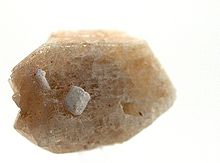|
Anorthoclase
The mineral anorthoclase ((Na,K)AlSi3O8) is a crystalline solid solution in the alkali feldspar series, in which the sodium-aluminium silicate member exists in larger proportion. It typically consists of between 10 and 36 percent of KAlSi3O8 and between 64 and 90 percent of NaAlSi3O8.[5]  Structure and stabilityAnorthoclase is an intermediate member of the high albite – sanidine alkali feldspar solid solution series. Intermediate members of this series, high albite, anorthoclase and high sodium sanidine are stable at temperatures of 600 °C (1,100 °F) and above. Below 400–600 °C (800–1,100 °F) only very limited solution exists (less than about 5% on both the low albite and microcline ends).[6] Anorthoclase and high albite exhibit triclinic symmetry, whereas sanidine and the low temperature orthoclase have monoclinic symmetry.[6] If the high temperature intermediate composition alkali feldspars are allowed to cool slowly, exsolution occurs and a perthite structure results.[6] OccurrenceAnorthoclase occurs in high temperature sodium rich volcanic and hypabyssal (shallow intrusive) rocks. The mineral is typically found as a constituent of the fine grained matrix or as small phenocrysts which may occur as loose crystals in a weathered rock.[2] It was first described in 1885 for an occurrence on Pantelleria Island, Trapani Province, Sicily. The name is from the Greek αν-, ορθός and κλάσις (not cleaving at right-angles), for its oblique cleavage.[2][3] See alsoReferences
|
||||||||||||||||||||||||||||||||||||||||||||||||||||||||
